This article is part of our Collette Calls series.
A quote that is often used in political debates very much applies to fantasy baseball.
"If you repeat a lie often enough, people will believe it."
In this case, fantasy baseball's lie is the Age 27 theory.
As the theory goes, players have breakout years at age 27, so targeting players who are turning 27 in a draft is a good way to pile up a lot of upside on your roster. Jose Abreu was 27 last year and had a huge fantasy season. Chris Davis was 27 in 2013 when he hit 53 home runs. Travis Hafner was 27 when he hit 28 homers, drove in 109, and had a .993 OPS in 2004. Josh Donaldson's coming out party to the rest of the world (#1 fan here!) came at age 27. There are certainly plenty of players that have had big seasons at age 27, but conveniently, we overlook the stinkbombs some players have put up in their "prime year."
Carlos Baerga had the worst season of his career (to that point) at age 27. Ken Caminiti lost 74 points o OPS from his age 26 season to his age 27 season. Johnny Damon, despite playing full seasons at both age 26 and 27, lost 190 points of OPS from one to the next. Just this past season, Jay Bruce had an epic stinkbomb of a year in his prime year, losing over 150 points of OPS. The simple fact is, for every age 27 breakout
A quote that is often used in political debates very much applies to fantasy baseball.
"If you repeat a lie often enough, people will believe it."
In this case, fantasy baseball's lie is the Age 27 theory.
As the theory goes, players have breakout years at age 27, so targeting players who are turning 27 in a draft is a good way to pile up a lot of upside on your roster. Jose Abreu was 27 last year and had a huge fantasy season. Chris Davis was 27 in 2013 when he hit 53 home runs. Travis Hafner was 27 when he hit 28 homers, drove in 109, and had a .993 OPS in 2004. Josh Donaldson's coming out party to the rest of the world (#1 fan here!) came at age 27. There are certainly plenty of players that have had big seasons at age 27, but conveniently, we overlook the stinkbombs some players have put up in their "prime year."
Carlos Baerga had the worst season of his career (to that point) at age 27. Ken Caminiti lost 74 points o OPS from his age 26 season to his age 27 season. Johnny Damon, despite playing full seasons at both age 26 and 27, lost 190 points of OPS from one to the next. Just this past season, Jay Bruce had an epic stinkbomb of a year in his prime year, losing over 150 points of OPS. The simple fact is, for every age 27 breakout in a given season, there is an age 27 flop. There is nothing magical about the age, but that does not mean that lie still persists.
These are recent examples of mock draft explanations I have seen that include comments about the mythical age:
"I hate being the one to take a pitcher in the first round, but Kershaw is a dominant one and I like his four-category impact over the other options in this spot. He can lead all starters in wins, ERA, WHIP and strikeouts. He is also smack dab in his prime at age 27."
"Upton is boring, I get it. He's also solid in the counting categories and offers something so many of the modern day ballplayers don't, which is stability, as he's appeared in 149 games in four straight seasons. Don't forget he's only 27 years old – still squarely in his physical prime."
"I will eventually pick position players. For now, I will have to be satisfied with having a 100-strikeout, 40-save closer with dynamite ratios. Oh, he just happens to be 27 this year, too, along with Clayton Kershaw."
There are many reasons to draft Clayton Kershaw, Justin Upton, or Aroldis Chapman. Their age should be well down the list of areas to investigate when rostering them or any other player in a draft.
Weighted on base average (wOBA) is an excellent way to measure a hitter's overall offensive value. Since offensive value fuels fantasy value, it is a good way of looking into player's offensive value as a whole rather than as a dollar amount or by counting stats.
The chart below shows how each age has performed based on wOBA over the past six seasons. The data looks at all non-pitchers that have played during any one of the past six seasons and breaks them down by age.
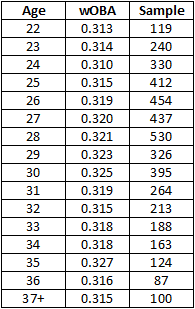
That same chart, in graphical form:
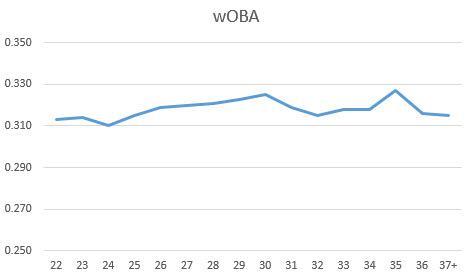
Now, what advantage does age 27 have over other ages? It is better than the ages before it, but not demonstrably better. Age 27 takes a back seat to the performances of 28 and 29-year-olds as well. There are a few reasons for this.
Few rookies hit the ground running. While the likes of Jose Abreu and Mike Trout spoil us, most players take time to start producing close to their projections. That time can come in their third year, or it could come later down the line. The numbers show that rather than a magical age, there is certainly a productive range of years for players before skills start to decline.
The behavior of that trend line can be explained by a few behaviors. The upward trend in the line from ages 24 to 30 is a combination of two factors. Primarily, players do better in the league with more experience in the league, so numbers should get better. Players also complete their physical growth in their early 20's. Lastly, the prospects that just don't cut it and would drag down the numbers are banished back to the minors. At 30, the numbers begin to slope down as Father Time takes over and starts to take away some of the fast twitch muscles and speed of a player's youth. Only the strong (and wily catchers) survive for one last moment in the sun before finally succumbing to Father Time.
The other issue is old data no longer meshes with new data. Just over a year ago, Jeff Zimmerman at FanGraphs showed how batters are declining in component stats at faster rates in recent seasons than they did from 1988-2005. His data showed that players are pretty much at their peak shortly after they're called up and it goes downhill from there.

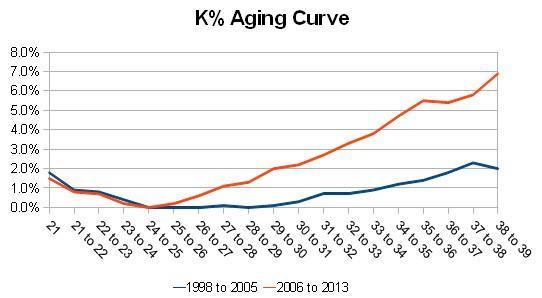
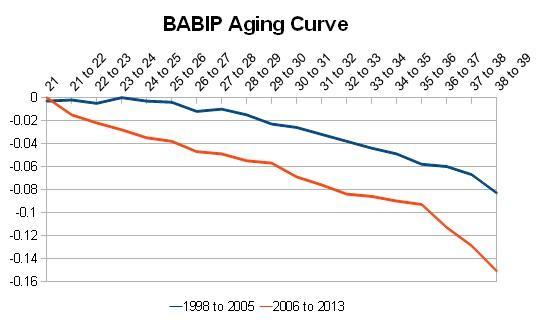
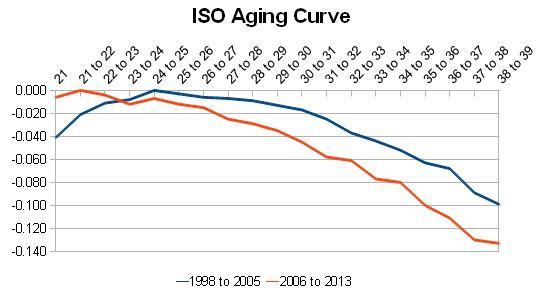
Each of those components affect a batter's batting average and power output. On top of all that decline, Mike Podhorzer showed that speed peaks early and then falls off, never to return.
What can we learn from all of this? Stop using age 27 for draft prep, unless you are looking specifically for speed. The Age 27 theory is junk science and is just as useful to identifying breakout players as physical attributes such as hair color, eye color, and handedness.










